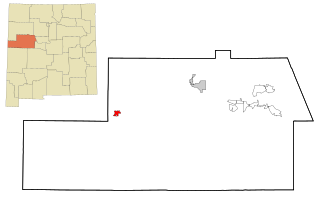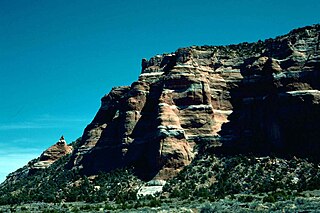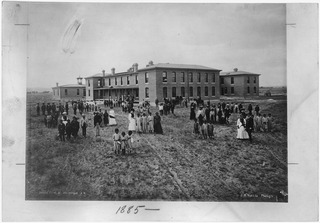Related Research Articles

McKinley County is a county in the northwestern section of the U.S. state of New Mexico. As of the 2020 United States Census, the population was 71,367. Its county seat is Gallup. The county was created in 1901 and named for President William McKinley.

Cibola County is a county in the U.S. state of New Mexico. As of the 2010 census, the population was 27,213. Its county seat is Grants. It is New Mexico's youngest county, and the third youngest county in the United States, created on June 19, 1981, from the westernmost four-fifths of the formerly much larger Valencia County.

Pinehill or Pine Hill is a census-designated place in Cibola County, New Mexico, United States. It is located on the Ramah Navajo Indian Reservation. The population was 88 at the 2010 census. The location of the CDP in 2010 had become the location of the Mountain View CDP as of the 2020 census, while a new CDP named "Pinehill" was listed 8 miles (13 km) further south, at a point 4 miles (6 km) southeast of Candy Kitchen.

Gallup /nɑ̀ʔnɪ́ʒòːʒɪ́/; Zuni: Kalabwaki) is a city in McKinley County, New Mexico, United States, with a population of 21,899 as of the 2020 census. A substantial percentage of its population is Native American, with residents from the Navajo, Hopi, and Zuni tribes. Gallup is the county seat of McKinley County and the most populous city between Flagstaff and Albuquerque, along the historic U.S. Route 66.

Ramah is a census-designated place (CDP) in McKinley County, New Mexico. The population was 407 at the time of 2000 census and 370 at the 2010 United States Census.

Tohatchi is a census-designated place (CDP) in McKinley County, New Mexico, in the Southwestern United States. It is known as a health services and education hub along Highway 491. The population was reported to be 785 at the 2020 census. As Tohatchi is located on the Navajo Nation, it is designated federal trust land.

Fort Wingate was a military installation near Gallup, New Mexico. There were two other locations in New Mexico called Fort Wingate: Seboyeta, New Mexico (1849–1862) and San Rafael, New Mexico (1862–1868). The most recent Fort Wingate (1868–1993) was established at the former site of Fort Lyon, on Navajo territory, initially to control and "protect" the large Navajo tribe to its north. The Fort at San Rafael was the staging point for the Navajo deportation known as the Long Walk of the Navajo. From 1870 onward the garrison near Gallup was concerned with Apaches to the south, and through 1890 hundreds of Navajo Scouts were enlisted at the fort.
Grants/Cibola County Schools is a school district based in Grants, New Mexico, United States.

The Zuni Indian Reservation, also known as Pueblo of Zuni, is the homeland of the Zuni tribe of Native Americans. In Zuni language, the Zuni Pueblo people are referred to as A:shiwi, and the Zuni homeland is referred to as Halona Idiwan’a meaning Middle Place.

The Ramah Navajo Indian Reservation is a non-contiguous section of the Navajo Nation lying in parts of west-central Cibola and southern McKinley counties in New Mexico, United States, just east and southeast of the Zuni Indian Reservation. It has a land area of 230.675 sq mi (597.445 km²), over 95 percent of which is designated as off-reservation trust land. According to the 2000 census, the resident population is 2,167 persons. The Ramah Reservation's land area is less than one percent of the Navajo Nation's total area.
Gallup-McKinley County Schools (GMCS) is a school district based in Gallup, New Mexico which serves students from Gallup and surrounding areas of McKinley County.
Zuni Public School District (ZPSD) is a school district headquartered in the Zuni Pueblo census-designated place of unincorporated McKinley County, New Mexico, United States.

The Bureau of Indian Education (BIE), headquartered in the Main Interior Building in Washington, D.C., and formerly known as the Office of Indian Education Programs (OIEP), is a division of the U.S. Department of the Interior under the Assistant Secretary for Indian Affairs. It is responsible for the line direction and management of all BIE education functions, including the formation of policies and procedures, the supervision of all program activities, and the approval of the expenditure of funds appropriated for BIE education functions.
Wingate High School is a Native American high school in unincorporated McKinley County, New Mexico, operated by the Bureau of Indian Education (BIE). It has grades 9-12. It has a Fort Wingate postal address.

Albuquerque Indian School (AIS) was a Native American boarding school in Albuquerque, New Mexico, which operated from 1881 to 1981. It was one of the oldest and largest off-reservation boarding schools in the United States. For most of its history it was run by the Bureau of Indian Affairs (BIA). Like other government boarding schools, AIS was modeled after the Carlisle Indian Industrial School, using strict military-style discipline to strip students of their native identity and assimilate them into white American culture. The curriculum focused on literacy and vocational skills, with field work components on farms or railroads for boys and as domestic help for girls. In the 1930s, as the philosophy around Indian education changed, the school shifted away from the military approach and offered more training in traditional crafts like pottery, weaving, and silversmithing.
Pine Hill Schools is a K-12 tribal school system operated by the Ramah Navajo School Board, Inc. (RNSB), in association with the Bureau of Indian Education (BIE), in Pine Hill, New Mexico.
Zuni High School (ZHS) is a public high school in Black Rock, New Mexico, with a Zuni Pueblo postal address. It is a part of the Zuni Public School District.
Tohatchi High School is a public high school in Tohatchi, New Mexico. It is a part of Gallup-McKinley County Schools.
Thoreau High School is a public high school in Thoreau, New Mexico. It is a part of Gallup-McKinley County Schools.
References
- ↑ "Home". Ramah Middle/High School. Retrieved 2022-01-11.
74 S. Bloomfield P.O. Box 849, Ramah, NM 87321
- Compare with the Ramah CDP map. The school has a Ramah address but is outside of the CDP. - ↑ "2020 CENSUS - SCHOOL DISTRICT REFERENCE MAP: McKinley County, NM" (PDF). U.S. Census Bureau . Retrieved 2021-07-20.
- ↑ "GMCS Address Lookup". Gallup-McKinley County Schools . Retrieved 2022-01-15. - KML files: Middle boundaries and locations, and High boundaries and locations.
- 1 2 3 4 5 Linthicum, Leslie (1995-03-06). "Navajos Say County Is Stealing Students". Albuquerque Journal . Albuquerque, New Mexico. pp. A1, A3. - Clipping of first and of second page at Newspapers.com. Page 2 text details: A, B, and C
- ↑ "2020 CENSUS - SCHOOL DISTRICT REFERENCE MAP: Cibola County, NM" (PDF). U.S. Census Bureau . Retrieved 2021-07-20.
- 1 2 3 4 "Ramah Faces Disapproval of High School". Albuquerque Journal . Albuquerque, New Mexico. 1968-03-31. p. D-1. - See clipping from Newspapers.com. Text detail A, Text detail B, Text detail C
- ↑ "Navajos to Vote on Ramah School". Albuquerque Journal . Albuquerque, New Mexico. Associated Press. 1952-03-30. p. 29. - Clipping from Newspapers.com.
- ↑ "Progress Seen in Indian Tuition Conversations". Albuquerque Journal . Albuquerque, New Mexico. Associated Press. 1952-04-03. p. 18. - See clipping from Newspapers.com.
- 1 2 Scott, Wayne S. (1968-03-23). "State Board Disapproves Substandard High Schools". Albuquerque Journal . Albuquerque, New Mexico. p. C-4. - Clipping from Newspapers.com.
- ↑ Rushton, Ted (1968-10-16). "Ramah School Suit Is Dismissed". The Gallup Independent . Vol. 79, no. 245. Gallup, New Mexico. pp. 1, 9. - Clipping of first and of second page by Newspapers.com.
- ↑ Bartel, Jon (1970-09-14). "'Am Pleased At Example'". The Gallup Independent . Vol. 81, no. 216. Gallup, New Mexico. pp. 1, 6. - Clipping of first and of second page at Newspapers.com.
- ↑ "Ramah Building Is Again Considered By Education Board". The Gallup Independent . Vol. 79, no. 285. Gallup, New Mexico. 1968-12-03. pp. 1, 5. - Clipping of first and of second page by Newspapers.com.
- ↑ "RNSB History". Ramah Navajo School Board . Retrieved 2021-07-20.
- 1 2 "Basketball's Big". Albuquerque Journal . 1999-02-28. p. A11. - See clipping from Newspapers.com.